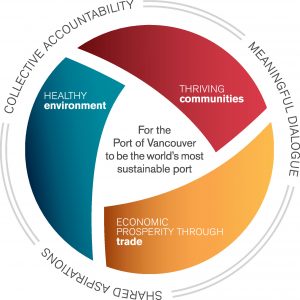We are on a journey to meet our vision to become the world’s most sustainable port. In 2010 we embarked on a two-year scenario planning process with stakeholders called Port 2050, to improve our understanding of what the region may look like in the future. We identified four plausible scenarios for the long-term future, including one we believe is worth aspiring to: The Great Transition. This scenario represents a shift to a lower-carbon economy that balances economic, environmental and social sustainability.
Since then, we have continued to work with the community and stakeholders to help us define what sustainability means for the Port of Vancouver, to revisit and refresh Port 2050, and to develop our vision.
We are now focusing on measuring progress towards our vision. This involves developing performance indicators based on what we believe are the most meaningful outcomes for the Port of Vancouver. We are continuously validating the importance of our measures as they relate to our sustainable port definition, through our reporting processes and through ongoing dialogue and engagement with stakeholders.
 What does it take to be the world’s most sustainable port?
What does it take to be the world’s most sustainable port?
We believe a sustainable port delivers economic prosperity through trade, maintains a healthy environment, and enables thriving communities, through meaningful dialogue, shared aspirations and collective accountability. Our definition of sustainability includes 10 areas of focus and 22 statements of success, which together describe the attributes of a sustainable port.
A sustainable port:
Competitive business
- Continuously improves efficiency and reliability, providing exceptional customer service
- Is profitable, delivering lasting value locally and nationally
- Reinforces innovation, diversity, resilience and adaptability
Effective workforce
- Maintains a skilled and productive workforce to meet current and future needs
- Provides an attractive work environment and rewarding career choices
Strategic investment and asset management
- Optimizes the use of land and infrastructure assets
- Anticipates and delivers infrastructure to meet capacity needs in a timely manner
A sustainable port:
Healthy ecosystems
- Takes a holistic approach to protecting and improving air, land and water quality to promote biodiversity and human health
- Champions coordinated management programs to protect habitats and species
Climate action
- Is a leader among ports in energy conservation and alternative energy to minimize greenhouse gas emissions
- Protects its assets against potential impacts of climate change
Responsible practices
- Improves the environmental, social and economic performance of infrastructure through design, construction and operational practices
- Supports responsible practices throughout the global supply chain
A sustainable port:
Good neighbour
- Proactively considers effects on communities in planning and managing operations
- Identifies and responds to community interests and issues
Community connections
- Strengthens national, regional and local prosperity, delivering regional benefits
- Engages communities and inspires pride in Canada as a trading nation
Indigenous relationships
- Respects First Nations’ traditional territories and value traditional knowledge
- Embraces and celebrates Indigenous culture and history
- Understands and considers contemporary interests and aspirations
Safety and security
- Upholds safety and security to protect port users and neighbouring communities
- Promotes a culture of emergency preparedness that supports rapid restoration of essential community services and business activities
To learn more about our approach to sustainability, read our Sustainability report 2022 or review past sustainability reports.
